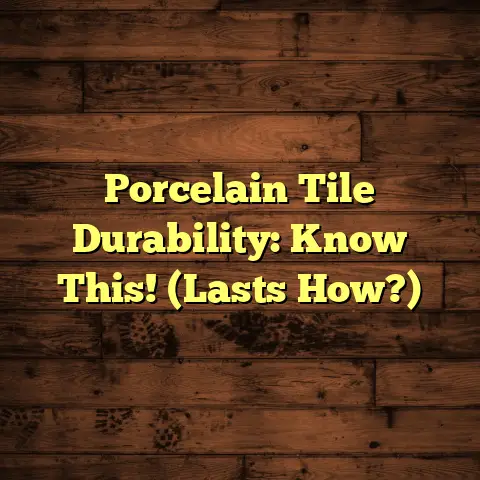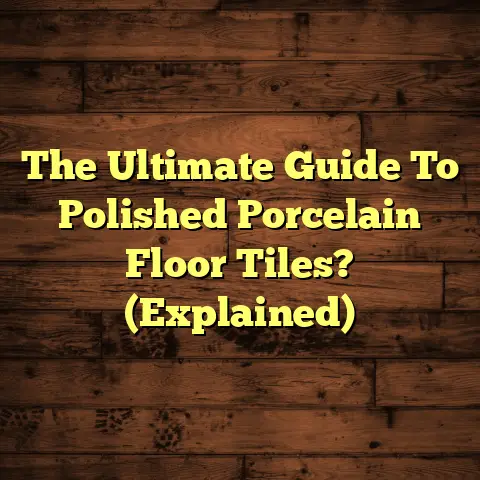Why My Floor Sounds Sticky? (3 Fixes NOW!)
Have you ever walked across your floor and heard that slightly embarrassing, squish-squish sound?
It’s like your shoes are stuck in slow-motion glue!
A lot of folks think that sticky floors are a sign of cheap materials.
Myth BUSTED!
I’ve been in the flooring business for over 15 years, and I can tell you that’s not always the case.
Sure, the type of flooring matters, but there are tons of other reasons your floor might be feeling (and sounding) a little too friendly.
Think of it this way: your floor is like a sponge.
It’s constantly interacting with its environment: humidity, spills, foot traffic – all of these things can contribute to that unwanted stickiness.
Don’t worry, you’re not alone!
Sticky floors are a super common problem, and usually, they’re pretty easy to fix.
Let’s dive into the why behind the stickiness and, more importantly, what you can do about it.
Section 1: Understanding the Causes of Sticky Floors
So, what’s making your floor feel like it’s trying to give you a hug?
Here are the usual suspects:
1. Moisture and Humidity
Think of your floor like a giant, thirsty plant.
It loves water (to a point!), but too much can cause problems.
How does humidity affect my floor?
High humidity can cause wood and laminate floors to expand.
Ever notice how doors stick in the summer?
Same principle!
According to the EPA, indoor humidity should be between 30-50%.
Anything higher can lead to mold growth and, you guessed it, sticky floors.
Spills and leaks:
These are the obvious culprits.
A forgotten spill under the fridge, a leaky pipe in the bathroom – these can all create sticky spots.
Real Talk:
I once had a client who complained about a sticky spot in her kitchen.
Turned out, her dog was secretly knocking over the water bowl when she wasn’t looking!
2. Dirt and Debris Buildup
Okay, let’s be honest: how often do you really clean your floors?
I’m not judging! Life gets busy.
But dirt, dust, and grime are like tiny magnets for stickiness.
Cleaning product residue:
This is a big one!
Many people use too much cleaning product, or don’t rinse properly.
This leaves a sticky film on the floor.
Household spills:
Think sugary drinks, cooking oil, even pet accidents.
These can all leave a sticky residue if not cleaned up thoroughly.
Fun Fact:
Did you know that dust is mostly made up of dead skin cells?
Ewww! That’s even more reason to clean regularly.
3. Improper Installation
This is where things get a little more technical.
If your floor wasn’t installed correctly, it can lead to all sorts of problems, including stickiness.
Acclimation:
Wood and laminate floors need to “acclimate” to the humidity of your home before installation.
If they don’t, they can expand or contract after being installed, leading to gaps and sticky spots.
Underlayment:
The underlayment is the material that goes between your subfloor and your flooring.
Using the wrong underlayment can cause moisture problems and affect the way your floor feels.
My Experience:
I once had to redo an entire hardwood floor because the installer didn’t let the wood acclimate properly.
Huge waste of time and money for the homeowner!
Section 2: Fixes for Sticky Floors
Alright, enough about the problems.
Let’s talk solutions!
Here are three fixes you can try right now to get rid of that sticky floor feeling.
Fix #1: Cleaning Techniques
Cleaning your floor properly is the first and most important step.
Here’s my foolproof method:
Sweep or vacuum: Get rid of any loose dirt or debris.
I recommend a vacuum with a soft brush attachment to avoid scratching your floor.Choose the right cleaner: This is crucial!
- Hardwood: Use a pH-balanced cleaner specifically designed for hardwood floors.
Avoid anything with wax or oil, as this can leave a sticky residue. - Laminate: Similar to hardwood, use a pH-balanced cleaner made for laminate.
- Tile: You can use a stronger cleaner for tile, but always test it in an inconspicuous area first.
- Mop with a microfiber mop: Microfiber mops are great because they trap dirt and don’t leave streaks.
- Hardwood: Use a pH-balanced cleaner specifically designed for hardwood floors.
Rinse, rinse, rinse! This is the most important step!
Use clean water to rinse away any remaining cleaning product.Dry the floor: Use a clean, dry towel to dry the floor.
This will prevent water spots and further residue buildup.
Pro Tip:
I always recommend cleaning your floors in sections.
This way, you can make sure you’re getting everything clean and dry.
Example:
I’ve had customers tell me that their floors are always sticky, no matter what they do.
After investigating, I often find that they’re using way too much cleaning product and not rinsing properly.
A simple change in technique can make a huge difference!
Fix #2: Humidity Control
Remember how we talked about humidity causing problems?
Well, controlling the humidity in your home is key to preventing sticky floors.
How to assess humidity levels:
You can buy a simple hygrometer at any hardware store.
This will tell you the humidity level in your home.
Dehumidifiers:
These are great for removing excess moisture from the air.
I recommend placing one in your basement or any other area that tends to be damp.
Humidifiers:
If your home is too dry, a humidifier can add moisture to the air.
This is especially important in the winter when the air is dry.
Ventilation:
Make sure your home is properly ventilated.
Open windows and doors when the weather allows.
Moisture barriers:
If you have a basement or crawl space, consider installing a moisture barrier.
This will prevent moisture from seeping into your home.
Real Story:
I once worked on a house where the humidity level was consistently above 70%.
The floors were constantly sticky, and there was even some mold growth.
After installing a dehumidifier and improving ventilation, the problem was solved.
Fix #3: Professional Assessment and Repair
Sometimes, no matter what you do, your floors are still sticky.
In these cases, it’s time to call in a professional.
When to call a pro:
- You’ve tried cleaning and controlling humidity, but the problem persists.
- You notice signs of water damage, such as warped boards or discoloration.
- You suspect that your floor was improperly installed.
What a professional might do:
- Assess the damage: They’ll be able to identify the cause of the stickiness and recommend the best course of action.
- Repair or replace damaged flooring: If the stickiness is caused by water damage or improper installation, they may need to repair or replace the affected areas.
- Reinstall the flooring: In some cases, the entire floor may need to be reinstalled.
Cost Considerations:
According to HomeAdvisor, the average cost to repair a wood floor is around $400, but this can vary depending on the extent of the damage.
Replacing a floor can cost anywhere from $5 to $15 per square foot.
Important Note:
I always recommend getting multiple quotes from different contractors before hiring someone.
Make sure they’re licensed and insured, and ask for references.
Final Thoughts:
I hope this article has helped you understand why your floor might be sounding a bit too friendly and what you can do to fix it.
Remember, sticky floors are a common problem, and they’re usually not a sign of poor-quality materials.
With the right cleaning techniques, humidity control, and, if necessary, professional help, you can get your floors back to feeling smooth and clean.
Don’t wait until the stickiness becomes a bigger problem.
Take action now and enjoy walking across your floors again!





